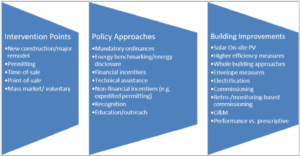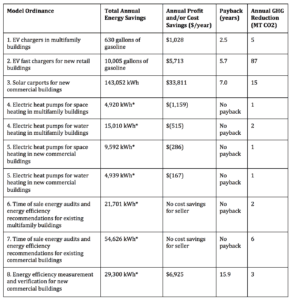
Model ordinances: Showing the way to a clean energy future
Model ordinances may sound a bit dry. But they’re one of several crucial policy approaches that will accelerate the transition to a clean energy future.
The Peninsula Advanced Energy Community (PAEC) just took a giant stepforward in creating Advanced Energy Communities (AECs): developing model clean energy ordinances for municipalities in California.
Model ordinances may sound a bit dry. But they’re one of several crucial policy approaches that will accelerate the transition to a clean energy future driven by AECs – communities that meet zero net energy standards for new buildings, include on-site renewables, and incorporate Solar Emergency Microgrids and electric vehicle (EV) charging capacity.
Municipal building and planning departments are on the front lines of the push to implement AECs. Model ordinances could help more municipalities ensure that clean energy building improvements happen at specific intervention points. The figure below breaks down the intervention points, policy options, and building improvements that will accelerate the creation of AECs.

To determine which model ordinances would be most useful in accelerating clean energy building improvements, the PAEC team worked with city officials in San Mateo County and consulted with the Regionally Integrated Climate Action Planning Suite (RICAPS), a coalition of city and county sustainability staff who meet regularly to work on climate action plans.
Working with RICAPS, the PAEC team collected feedback through online surveys and focus groups. Based on this input, the team moved forward to study eight clean energy topics for potential model ordinances:
- Policy 1: EV level II chargers in multifamily buildings with 50% cost-sharing
- Policy 2: EV fast chargers for new retail buildings requiring pre-wiring or full installation
- Policy 3: Solar carports for new commercial buildings
- Policy 4: Electric heat pumps for space and water heating in multifamily buildings
- Policy 5: Electric heat pumps for space and water heating in new commercial buildings
- Policy 6: Time of sale energy audits and disclosure of energy efficiency recommendations for existing multifamily buildings
- Policy 7: Time of sale energy audits and disclosure of energy efficiency recommendations for existing commercial buildings
- Policy 8: Energy efficiency measurement and verification for new commercial buildings to ensure buildings perform as designed
The PAEC team analyzed each of these policies for economic feasibility and greenhouse gas reduction potential. In the benefit cost analysis, PAEC assumed $0.236/kilowatt-hour (kWh) for electricity and $1.122/therm for natural gas. The results appear in the table below.

Policies 1, 2, 3, and 8 were winners from an economic analysis point of view. These four policies were net present value positive, which means the cost savings paid for the initial investment before the end of the equipment’s projected lifetime. Prioritizing these four cost-effective policies led PAEC to develop four model ordinances. Now, municipalities throughout California can use these model ordinances by simply altering them with a few details specific to their jurisdiction.
Model ordinances are just one important tool in the AEC acceleration toolkit. Policy approaches that do not lend themselves to economic analyses can also be useful – such as streamlining the clean energy permitting process, or providing incentives, recognition, and education.
From a larger perspective, it’s important to develop appropriate policy levers that realize overall societal benefits without overburdening specific stakeholders such as building owners, renters, and real estate agents. Therefore, a key priority for the PAEC initiative is to continue engaging effective stakeholders who can assist in developing a toolkit that can be used by communities across California and beyond.
PAEC is a groundbreaking initiative to streamline policies and showcase projects that facilitate local renewables and other advanced energy solutions like energy efficiency, energy storage, and electric vehicle charging infrastructure. PAEC will create pathways to cost-effective clean local energy and community resilience throughout San Mateo County, the City of Palo Alto, and beyond. PAEC is a collaboration between the Clean Coalition, the California Energy Commission, Pacific Gas and Electric, and an array of municipalities, emergency response jurisdictions, schools and universities, and corporate entities. For more information, please visitwww.clean-coalition.org/PAEC.
*Denotes net energy savings (based on both therms and electricity)

